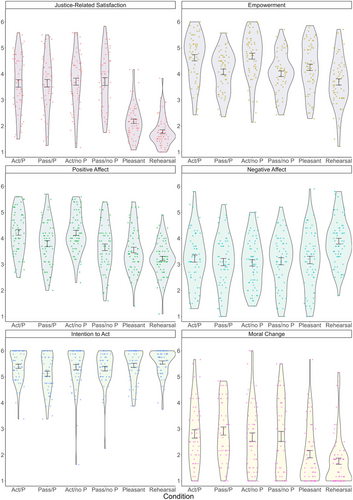Correction to “Victim empowerment and satisfaction: The potential of imagery rescripting”
We would like to bring to your attention an error in Figure 1 of our published article titled “Victim Empowerment and Satisfaction: The Potential of Imagery Rescripting” in the European Journal of Social Psychology (https://doi.org/10.1002/ejsp.3073).
- - The condition labelled “Act/P” (Active ImRs & Punishment) should read “Act/no P” (Active ImRs & no Punishment).
- - The condition labelled “Pass/P” (Passive ImRs & Punishment) should read “Act/P” (Active ImRs & Punishment).
- - The condition labelled “Act/no P” (Active ImRs & no Punishment) should read “Pleasant” (Pleasant Imagery).
- - The condition labelled “Pass/no P” (Passive ImRs & no Punishment) should read “Rehearsal” (Imagery Rehearsal).
- - The condition labelled “Pleasant” (Pleasant Imagery) should read “Pass/no P” (Passive ImRs & no Punishment).
- - The condition labelled “Rehearsal” (Imagery Rehearsal) should read “Pass/P” (Passive ImRs & Punishment).

-
Active ImRs & no Punishment
-
Active ImRs & Punishment
-
Pleasant Imagery
-
Imagery Rehearsal
-
Passive ImRs & no Punishment
-
Passive ImRs & Punishment
Importantly, this error solely pertains to the labelling of the horizontal axes in Figure 1 and does not affect the validity of the data, analyses, or interpretations presented in the article. The means and standard deviations for all dependent variables across experimental conditions are reported correctly in Table 2 of the published article.
To address this oversight, we conducted a thorough re-evaluation of our R code and analytical processes. We can confirm that the results as well as the interpretations discussed in the article remain consistent and unaffected by this labelling error.
The corrected figure below accurately represents the experimental conditions on the horizontal axes. We sincerely apologize for any confusion or inconvenience caused by this oversight.




